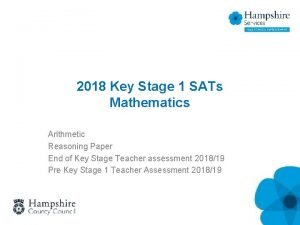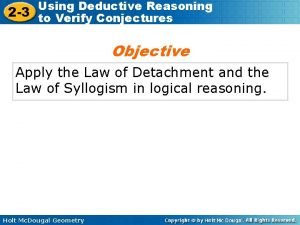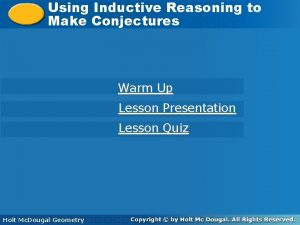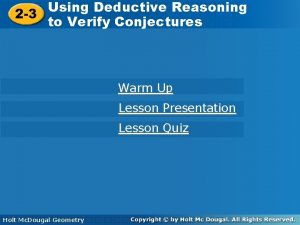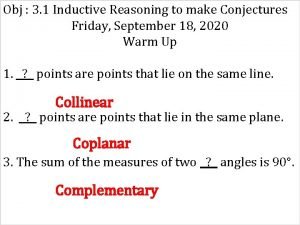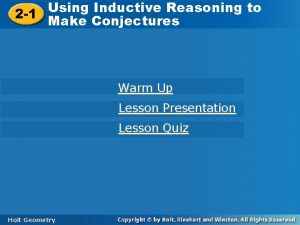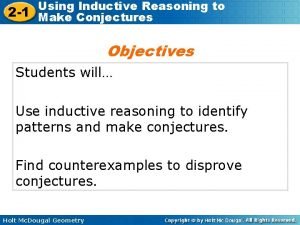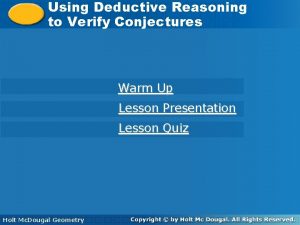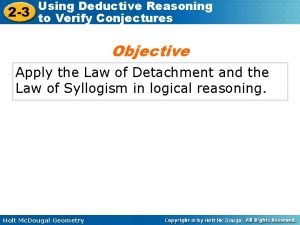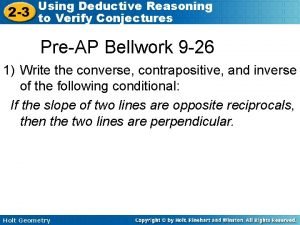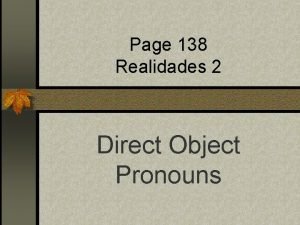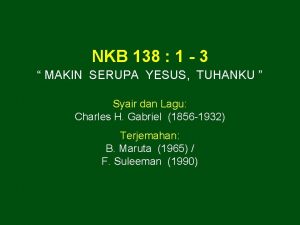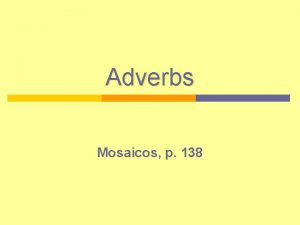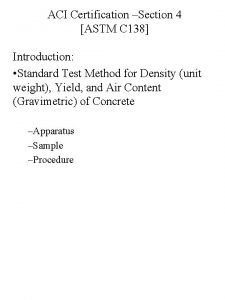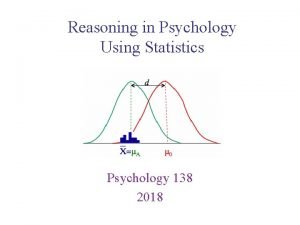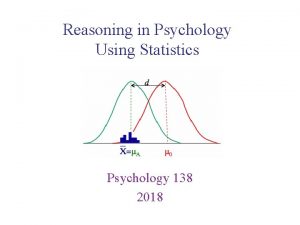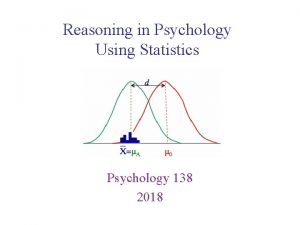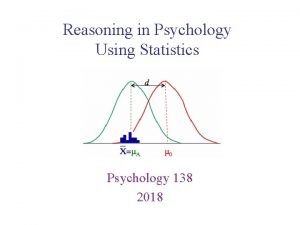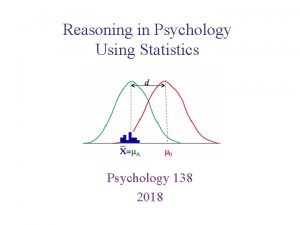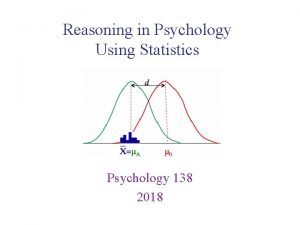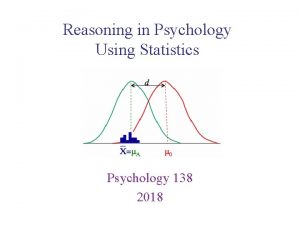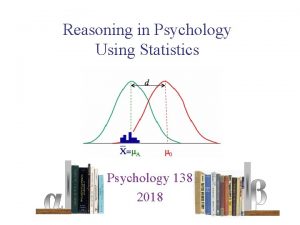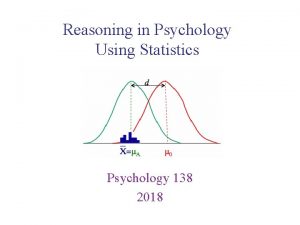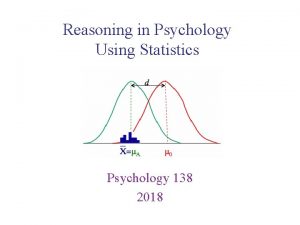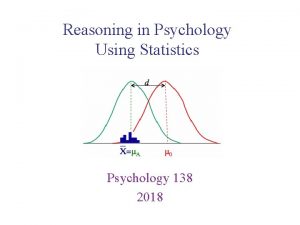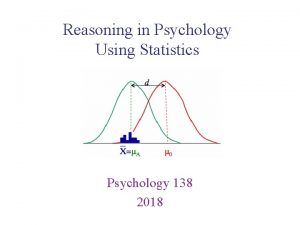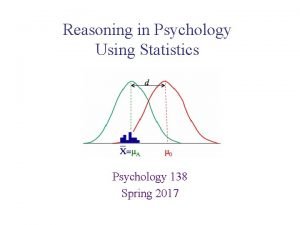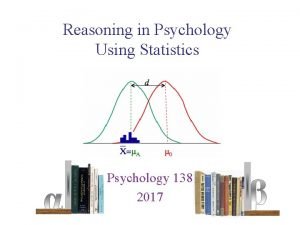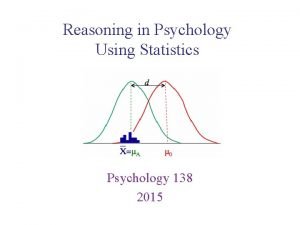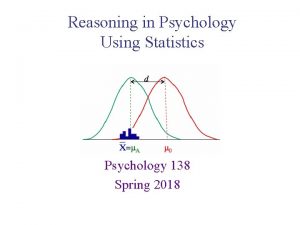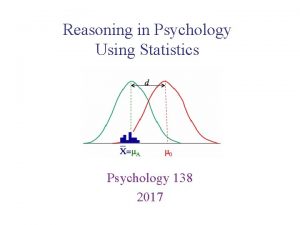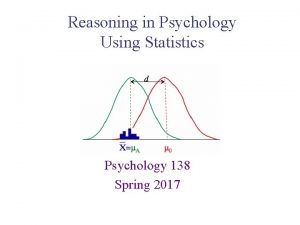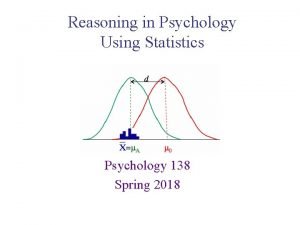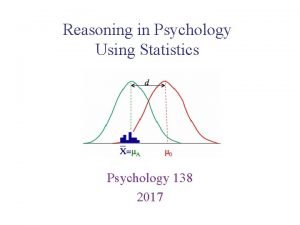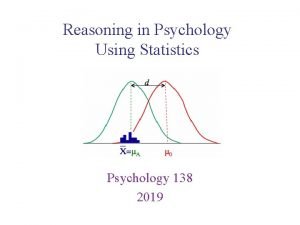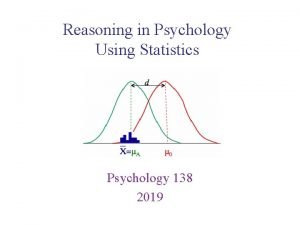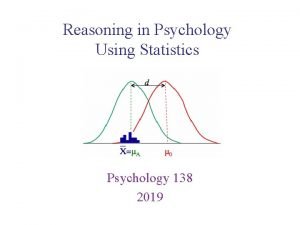Reasoning in Psychology Using Statistics Psychology 138 2018





























- Slides: 29

Reasoning in Psychology Using Statistics Psychology 138 2018

• Don’t forget Quiz 1, due this Friday, Jan. 26 • Exam 1 not far away, Wed Feb 7 th Announcements Social Science Reasoning Using Statistics

• Scientific Method – Ask research question – Identify variables and formulate hypothesis Where do the data come from? – Define population • Experiments method • Independent variables – Select research methodology • Dependent variables – Collect data from sample • Observational method • Explanatory variables – Analyze data • Response variables – Draw conclusions based on data – Repeat Measuring Manipulating Variables From lastand time Social Science Reasoning Using Statistics

Claim: Absence makes the heart grow fonder • What are the variables in this claim? Explanatory (independent) variable Response (dependent) variable Measuring and Manipulating Variables Social Science Reasoning Using Statistics

Claim: Absence makes the heart grow fonder • Two levels of variables – Conceptual level of variables (abstract) • What theory is about (absence, fondness) Operational definition – Specifies relationship between conceptual & operational levels – Operational level of variables (concrete) • What actually manipulated/measured in research – Duration of time apart – Rated fondness Measuring and Manipulating Variables Social Science Reasoning Using Statistics Read the methods of actual example: Jiang & Hancock (2013)

Operational definition – Specifies relationship between conceptual & operational levels 1. 2. Describes set of operations or procedures (the instrument) for measuring conceptual variable Defines the variable in terms of measurement Measuring and Manipulating Variables Social Science Reasoning Using Statistics

Claim: Absence makes the heart grow fonder What do we mean by absence? Two people involved in relationship having to be apart for a long time. How do we measure (or manipulate) absence? Amount of time apart, number of visits, distance one of these or perhaps a combination Measuring Variables Social Science Reasoning Using Statistics

Claim: Absence makes the heart grow fonder So what do we mean by heart grow fonder? • Strength of relationship • Level of desire How do we measure fondness of the heart? • Have couple rate fondness for one another • Hook each to brain monitor & record while seeing pictures of sweetheart & pictures of other people Measuring Variables Social Science Reasoning Using Statistics Survey Brainwave machine

Claim: Absence makes the heart grow fonder • Choosing your instrument • How might these measures be different? • What impact might these differences have? Survey How fond are you of your partner? Not at all Somewhat Very much 1 - 2 - 3 - 4 - 5 Brainwave machine Measuring Variables Social Science Reasoning Using Statistics

• Properties of measurement – Unit of measurement – Scale of measurement • Error in measurement – Validity – Reliability Social Science Reasoning Using Statistics Measurement: Quantitative Research

• Properties of measurement – Unit of measurement - minimum sized unit – Scale of measurement • Error in measurement – Validity – Reliability Social Science Reasoning Using Statistics Measurement: Quantitative Research

• Continuous variables – Variables can take any number & be infinitely broken down into smaller & smaller units – E. g. , For lunch I can have 2, 3, or 2. 5 cookies • Discrete variables – Broken into a finite number of discrete categories that can’t be broken down – E. g. , In my family I can have 1 kid or 2 kids, but not 2. 5 Units of Measurement Social Science Reasoning Using Statistics

• Properties of measurement – Unit of measurement – Scale of measurement - correspondence between properties of numbers & variables measured • Stevens (1946) Typology – Categorical variables: Nominal & Ordinal Scales » Set of discrete kinds of things (categories) » Can attach names to these categories – Quantitative variables: Interval and Ratio Scales » Distinct levels with differing amounts of characteristic of interest » Can attach numbers to these amounts Which scale you use will impact what statistics you can perform and how you should interpret your analyses Social Science Reasoning Using Statistics Measurement: Quantitative Research

• Nominal Scale: Consists of a set of categories that have different names. – Measurements on a nominal scale label and categorize observations, but do not make any quantitative distinctions between observations. – Example: • Eye color: blue, green, brown, hazel Scales of measurement Social Science Reasoning Using Statistics

• Ordinal Scale: Consists of a set of categories that are organized in an ordered sequence. – Measurements on an ordinal scale rank observations in terms of size or magnitude. – Example: • T-shirt size: Small, Med, Lrg, XL, XXL Scales of measurement Social Science Reasoning Using Statistics Think about Restaurant ratings

• Interval Scale: Consists of ordered categories where all of the categories are intervals of exactly the same size. – With an interval scale, equal differences between numbers on the scale reflect equal differences in magnitude. – Ratios of magnitudes are not meaningful. – Example: • Fahrenheit temperature scale 40º 20º “Not Twice as hot” Scales of measurement Social Science Reasoning Using Statistics

• Ratio scale: An interval scale with the additional feature of an absolute zero point. • With a ratio scale, ratios of numbers DO reflect ratios of magnitude. – It is easy to get ratio and interval scales confused – Consider the following example: Measuring your height with playing cards Scales of measurement Social Science Reasoning Using Statistics

Ratio scale 8 cards high Scales of measurement Social Science Reasoning Using Statistics

Interval scale 5 cards high Scales of measurement Social Science Reasoning Using Statistics

Ratio scale 8 cards high 0 cards high means ‘no height’ Interval scale 5 cards high 0 cards high means ‘as tall as the table’ Scales of measurement Social Science Reasoning Using Statistics

In SPSS Scale of Measure: Nominal, Ordinal, Scale (interval or ratio) – in the variable view Scales of measurement Social Science Reasoning Using Statistics

• Properties of measurement – Unit of measurement – Scale of measurement • Error in measurement – Validity – Reliability Social Science Reasoning Using Statistics Measurement: Quantitative Research

• Validity – Does our measure really measure the construct? (accuracy/precision) • Think about the operational definition – Is there bias in our measurement? • Systematic error • Reliability – Do we get the same score with repeated measurements? Errors in measurement Social Science Reasoning Using Statistics

Dart board represents Population of all possible scores Center represents the true score Collection of ‘darts’ is a sample of measurements The center of the sample is the estimate of the true score Dart board example Social Science Reasoning Using Statistics

Low variability/low bias Points are all close together (similar) & Centered on the target Reliable & Valid measure Dart board example Social Science Reasoning Using Statistics

Low variability/high bias Points are all close together (similar) & NOT centered on the target Reliable but Invalid measure Dart board example Social Science Reasoning Using Statistics

High variability/low bias Points are NOT all close together (dissimilar)& Centered on the target Valid but Unreliable measure Dart board example Social Science Reasoning Using Statistics

Unreliable & invalid measure High variability/high bias Points are NOT all close together (dissimilar) & NOT centered on the target Dart board example Social Science Reasoning Using Statistics

• Today’s lab: Measurement • Questions? SPSS Operational Definitions: Measuring Happiness (~2 mins) Operational Definitions (~20 mins) Scales of measurement (~6 mins) Scales of measurement (~7 mins) Scales of measurement (~15 mins) Reliability and validity (~ 2 mins) Wrap up Social Science Reasoning Using Statistics
 Definition of inductive method
Definition of inductive method Inductive reasoning vs deductive reasoning
Inductive reasoning vs deductive reasoning Inductive vs deductive reasoing
Inductive vs deductive reasoing Inductive and deductive reasoning geometry examples
Inductive and deductive reasoning geometry examples Every quiz has been easy. therefore, the quiz will be easy
Every quiz has been easy. therefore, the quiz will be easy Inductive reasoning patterns
Inductive reasoning patterns Inductive reasoning deductive reasoning
Inductive reasoning deductive reasoning Arithmetic sats 2018
Arithmetic sats 2018 Dada la siguiente secuencia rusia 2018 rusia 2018
Dada la siguiente secuencia rusia 2018 rusia 2018 Hashtags twitter statistics
Hashtags twitter statistics Global exhibition industry statistics 2018
Global exhibition industry statistics 2018 Introduction to statistics what is statistics
Introduction to statistics what is statistics Using deductive reasoning to verify conjectures
Using deductive reasoning to verify conjectures Using inductive reasoning to make conjectures answers
Using inductive reasoning to make conjectures answers Using deductive reasoning to verify conjectures
Using deductive reasoning to verify conjectures Using inductive reasoning to make conjectures
Using inductive reasoning to make conjectures Making conjectures inductive reasoning
Making conjectures inductive reasoning Using inductive reasoning to make conjectures
Using inductive reasoning to make conjectures Using deductive reasoning to verify conjectures
Using deductive reasoning to verify conjectures Using deductive reasoning to verify conjectures
Using deductive reasoning to verify conjectures Using deductive reasoning to verify conjectures
Using deductive reasoning to verify conjectures Salmo 138 6
Salmo 138 6 Direct object pronouns (p. 138)
Direct object pronouns (p. 138) Nkb 194
Nkb 194 Nota kawad kaki kesatria negara uitm
Nota kawad kaki kesatria negara uitm Double.object pronouns spanish
Double.object pronouns spanish Adverb placement
Adverb placement Aci c138
Aci c138 Psalm 138 1-3
Psalm 138 1-3 Tiempo de orar salmo 138
Tiempo de orar salmo 138







